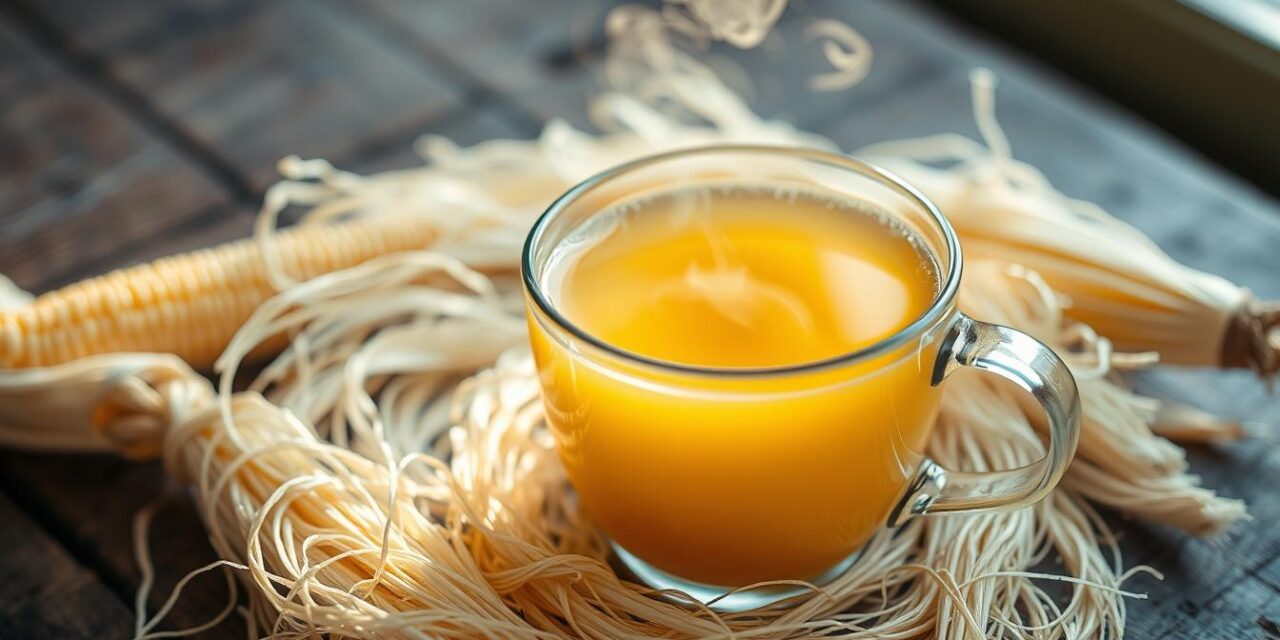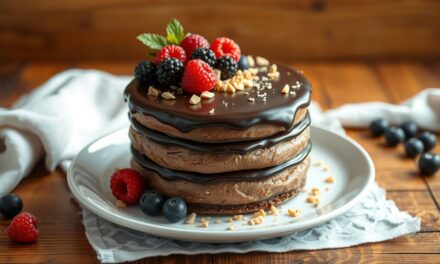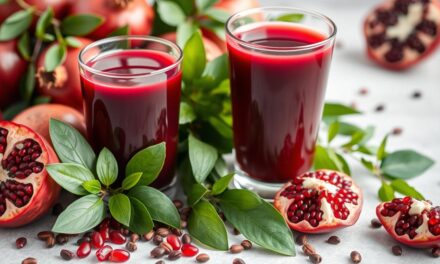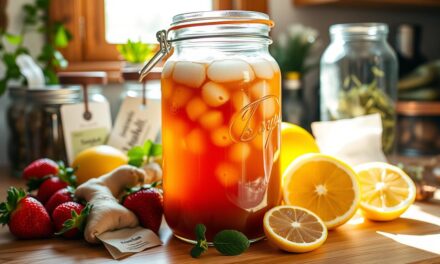Did you know that cornsilk, the delicate threads in corn cobs, can make a powerful herbal tea? This natural remedy has been used for centuries in traditional medicine worldwide. Its health benefits are now widely recognized.
Cornsilk tea is a natural herbal infusion rich in minerals like potassium, magnesium, and zinc. It’s not just about the nutrients. This tea also has antioxidant, anti-inflammatory, and kidney-supporting properties. It’s a true treasure in natural health and wellness.
Key Takeaways
- Cornsilk tea is a traditional herbal remedy with a long history of use in various cultures.
- It is rich in essential minerals and antioxidants that support overall health and wellbeing.
- Cornsilk tea has been linked to benefits for the urinary system, inflammatory conditions, and blood sugar management.
- Proper preparation and consumption guidelines can help you maximise the therapeutic potential of this natural tea.
- Cornsilk tea can be combined with other herbal remedies for enhanced health-promoting effects.
Understanding What Cornsilk Tea Is and Its Origins
Cornsilk tea, also known as maize tea or zea mays tea, comes from the fine strands at corn cobs’ tops. It’s a natural product with a long history. It’s used in many cultures worldwide.
Traditional Uses Across Different Cultures
For centuries, people in the Americas and Asia have drunk cornsilk tea. In the Americas, the Aztecs and Native Americans valued it for healing. In Traditional Chinese Medicine, it’s used for its ability to help with urine flow and reduce inflammation.
How Cornsilk Tea Is Harvested and Processed
- Cornsilk is picked by hand from mature corn plants in late summer or early autumn.
- Then, it’s dried carefully, often in the sun or with low heat, to keep its natural goodness.
- After drying, the cornsilk is processed and packaged to keep it fresh and of high quality.
The Botanical Properties of Zea Mays Silk
Cornsilk comes from the Zea mays plant, also known as maize or corn. The fine strands from the corn cobs are the plant’s stigmas. They help with pollination and are full of good stuff like flavonoids, alkaloids, and vitamins. These make cornsilk tea special and healthy.
| Botanical Name | Common Names | Plant Part Used |
|---|---|---|
| Zea mays | Corn, Maize | Corn Silk |
The Essential Nutrients Found in Cornsilk Tea
Cornsilk tea is a caffeine-free tisane, full of essential nutrients. It comes from the silky strands of the maize plant. This herbal infusion has a rich nutritional profile, which may help with health.
This tea is great because it doesn’t have caffeine. It’s perfect for those who don’t want stimulants. It’s also packed with vitamins and minerals that support the body gently.
| Nutrient | Amount per Serving |
|---|---|
| Vitamin K | 25 mcg |
| Vitamin C | 10 mg |
| Magnesium | 20 mg |
| Potassium | 150 mg |
| Zinc | 1 mg |
Cornsilk tea also has phytochemicals and antioxidants. These include flavonoids, sterols, and saponins. They may help fight inflammation and protect against damage.
Adding this caffeine-free tea to your daily routine is easy. It’s a natural way to enjoy the corn silk benefits. You can drink it as a soothing tisane or use it in wellness routines. It’s a versatile and nutritious drink to try.
Powerful Health Benefits of Natural Cornsilk Tea
Cornsilk tea is made from the silk-like strands of the corn plant. It’s known for its health benefits. It supports kidney and urinary health, has anti-inflammatory properties, and helps manage blood sugar.
Supporting Kidney and Urinary Health
Cornsilk tea acts as a natural diuretic. It has compounds like flavonoids and silicic acid. These help increase urine output and remove toxins and excess fluid.
This is good for people with urinary tract infections, kidney stones, or other urinary issues.
Anti-inflammatory Properties and Applications
Cornsilk tea is also known for its anti-inflammatory properties. It has a lot of polyphenols. These can reduce inflammation in the body.
This makes it useful for conditions like arthritis, chronic pain, and skin irritations. Drinking cornsilk tea daily can help manage inflammation and support your overall health.
Blood Sugar Management Support
Research shows cornsilk tea may help with blood sugar regulation. It has antioxidants and phytochemicals. These can improve insulin sensitivity and slow glucose absorption.
This is good for people with type 2 diabetes or those who want to keep their blood sugar levels healthy.
| Health Benefit | Potential Mechanisms | Clinical Evidence |
|---|---|---|
| Kidney and Urinary Health | Diuretic properties, toxin/fluid removal | Numerous studies have shown cornsilk’s efficacy in reducing urinary tract infections, kidney stones, and other urinary issues. |
| Anti-inflammatory Effects | Polyphenol content, reduction of inflammatory markers | Multiple clinical trials have demonstrated cornsilk’s ability to alleviate inflammation in conditions like arthritis and chronic pain. |
| Blood Sugar Management | Improved insulin sensitivity, delayed glucose absorption | Preliminary research suggests cornsilk may have a positive impact on blood sugar regulation, though more studies are needed. |
Cornsilk tea is a natural, versatile herbal tea. It offers many health benefits. It’s great for supporting your urinary system, managing inflammation, and keeping blood sugar levels healthy. Adding it to your routine can be a gentle, holistic way to improve your wellbeing.
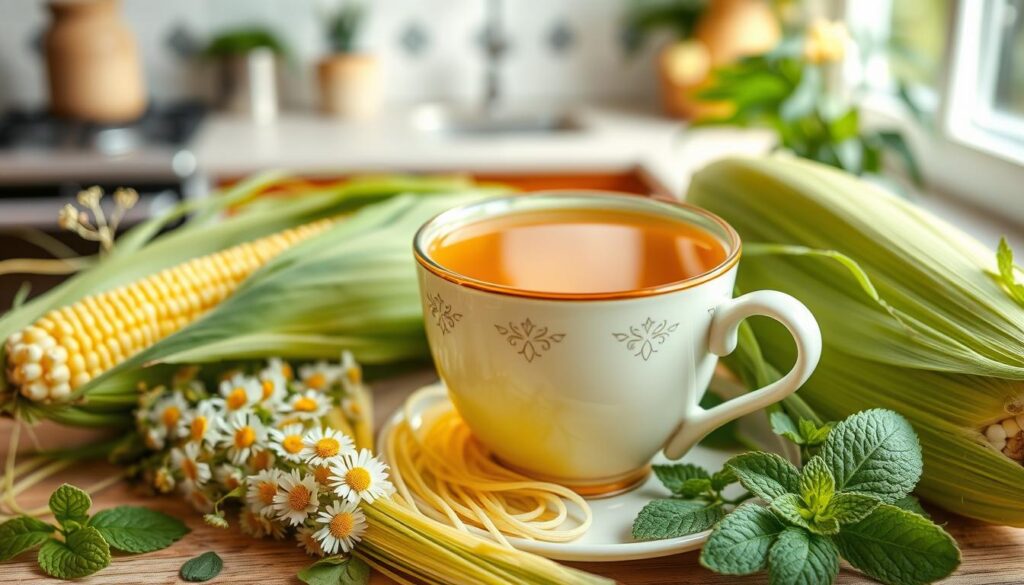
How to Properly Prepare and Brew Cornsilk Tea
Making a great cup of cornsilk tea is easy. It’s perfect for a calming herbal drink or for getting the health perks of cornsilk. Learning how to prepare it right is key to enjoying its benefits fully.
First, find top-notch cornsilk. It’s also known as maize silk. Choose organic, pesticide-free corn silk that’s been dried well to keep its good stuff.
- Start by heating fresh, filtered water to a soft boil. The best temperature for cornsilk tea is between 195°F and 205°F (91°C to 96°C).
- Put 1-2 teaspoons of dried cornsilk in 8 ounces (240 ml) of water. You can adjust this based on how strong you like it.
- Put the cornsilk in a teapot, infuser, or tea bag. Pour the hot water over it. Let it steep for 5-10 minutes, depending on how strong you want it.
- After steeping, take out the cornsilk. Pour the tea into your favourite mug or cup.
For the best taste and freshness, drink cornsilk tea right after making it. But if you want to have it later, you can keep it in the fridge in an airtight container for up to 3 days.
| Preparation Tip | Benefit |
|---|---|
| Use freshly drawn, filtered water | Ensures the tea is free from impurities and chlorine, which can impact the taste and quality |
| Adjust steeping time to suit your preference | Longer steeping results in a more robust, concentrated flavour, while shorter steeping provides a lighter, more delicate infusion |
| Store unused cornsilk in an airtight container | Preserves the herb’s potent compounds and prevents loss of freshness |
By following these easy steps, you can enjoy the full taste and health benefits of cornsilk tea. So, sit back, relax, and let the soothing and nourishing qualities of cornsilk tea work their magic.

Optimal Dosage and Best Times to Drink Cornsilk Tea
Timing and dosage are crucial when adding cornsilk tea to your daily routine. Experts say the best time to drink it can change based on your health goals and the season.
Morning vs Evening Consumption
Many people start their day with cornsilk tea for a refreshing boost. Its diuretic properties support kidney and urinary health. Yet, some find it calms them down in the evening.
Recommended Daily Intake Guidelines
- For general wellness, aim for 1-2 cups of cornsilk tea daily.
- If you’re tackling specific health issues, like urinary problems, try 2-3 cups a day.
- Always check with a doctor to find the right amount for you. Your age, health, and meds can affect it.
Seasonal Consumption Patterns
The way we drink herbal tea varieties like cornsilk can change with the seasons. In summer, its diuretic effects help with staying hydrated. In winter, its anti-inflammatory and soothing qualities are more beneficial.
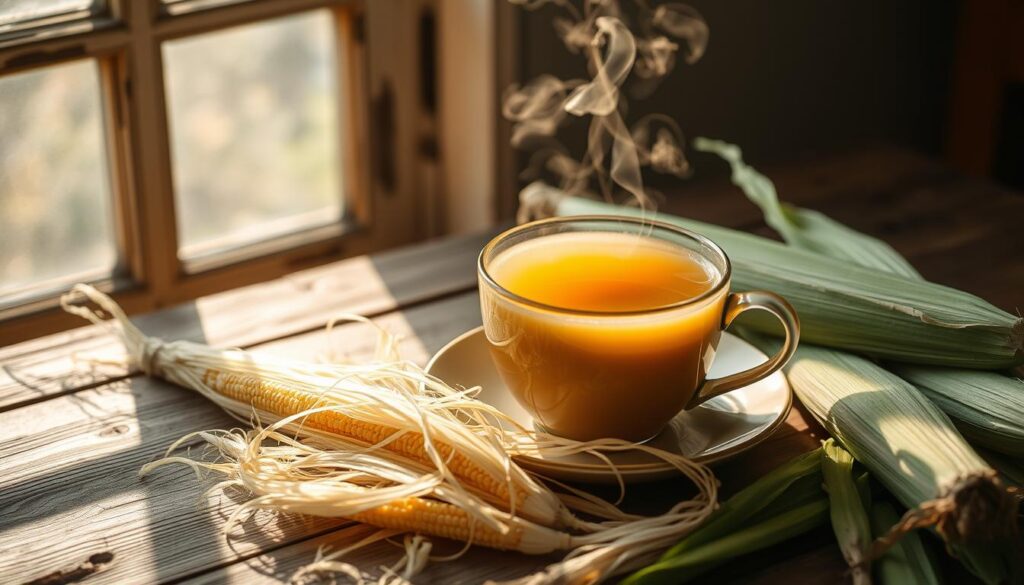
It’s important to pay attention to how your body reacts. Adjust your cornsilk tea intake to get the most health benefits.
Potential Side Effects and Precautions
Organic corn silk tea is usually safe and natural. But, it’s good to know about possible side effects and precautions. When you drink natural cornsilk tea, there are a few things to remember.
Potential Side Effects
- Gastrointestinal discomfort: Some people might feel a bit sick in their stomach, get nausea, or have diarrhoea. This can happen, especially if you drink too much.
- Allergic reactions: It’s rare, but some might have an allergic reaction. This could be skin rashes or breathing problems if you’re sensitive to corn or related plants.
- Lowered blood pressure: Drinking cornsilk tea might make your blood pressure go down. This could be a problem if you already have low blood pressure.
Precautions and Interactions
Be careful or talk to a doctor before drinking organic corn silk tea if you have:
- Diabetes: It might affect your blood sugar levels because it can interact with diabetes medicines.
- Kidney or liver disease: The diuretic effect of cornsilk could make kidney or liver problems worse.
- Pregnancy and breastfeeding: There’s not much research on its safety during these times. It’s best to avoid it or ask a doctor.
- Medications: It might not mix well with certain medicines like blood thinners, diuretics, and diabetes drugs.
If you have any health issues or feel bad after drinking it, always talk to a doctor. They can help you decide if it’s safe for you.
| Potential Side Effects | Precautions and Interactions |
|---|---|
|
|
Knowing about these side effects and precautions helps you use organic corn silk tea safely. It’s a good addition to your natural herbal routine.
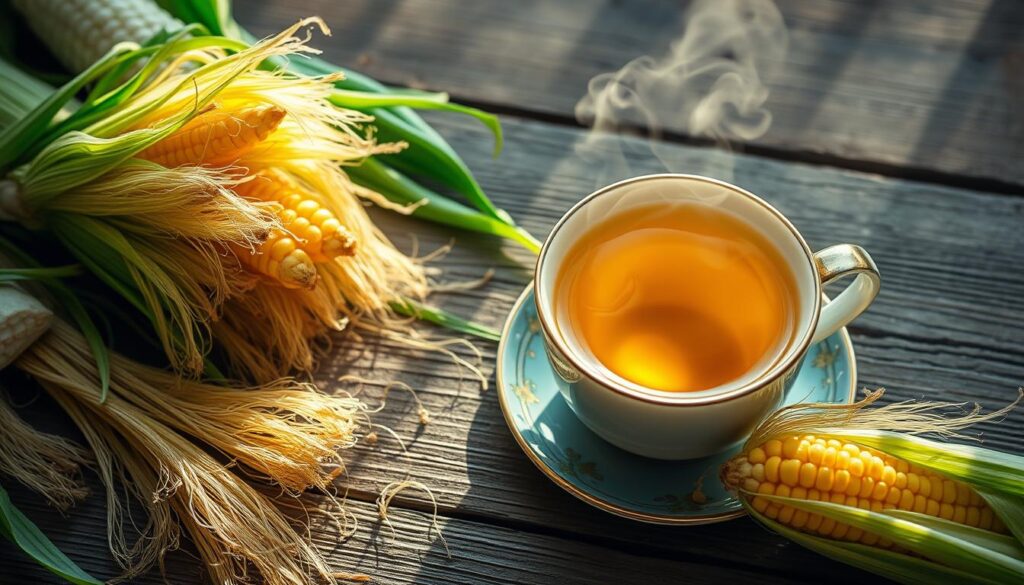
Combining Cornsilk Tea with Other Herbal Remedies
Cornsilk tea is a traditional herbal remedy that can be enjoyed alone or with other natural ingredients. Mixing it with other herbs can unlock new wellness possibilities. This approach is great for those looking for holistic health solutions.
Compatible Herb Combinations
Cornsilk tea goes well with many herbal teas and extracts. Each one brings its own special benefits. Here are some good combinations:
- Cornsilk tea and green tea – for a antioxidant-rich beverage
- Cornsilk tea and chamomile – to promote relaxation and sleep
- Cornsilk tea and ginger – to support digestive health
- Cornsilk tea and turmeric – to harness anti-inflammatory benefits
Enhanced Therapeutic Effects
When you mix cornsilk tea with other herbs, it can work even better. For instance, adding bearberry leaf or cranberry can help with urinary tract and kidney health. Mixing it with dandelion or milk thistle can boost its natural diuretic and detoxifying effects.
Trying out different herbal teas and tinctures can lead to unique wellness experiences. But, always talk to a healthcare professional first. This ensures the mix is safe and effective.
| Herb Combination | Potential Benefits |
|---|---|
| Cornsilk Tea + Green Tea | Antioxidant-rich beverage |
| Cornsilk Tea + Chamomile | Promotes relaxation and sleep |
| Cornsilk Tea + Ginger | Supports digestive health |
| Cornsilk Tea + Turmeric | Harnesses anti-inflammatory benefits |
Sustainable Harvesting and Environmental Impact
The demand for corn products, like cornsilk tea, is growing fast. It’s important to think about how they affect the environment. Zea mays, or corn, is grown all over the world. We need to grow it in a way that keeps our ecosystems healthy.
Using sustainable methods to harvest corn is key. This means growing crops in a way that doesn’t harm the planet. Techniques like crop rotation and using organic fertilizers help a lot. They also help save water, which is good for our planet.
Using cornsilk in tea is also good for the environment. Instead of throwing away the silky threads from corn cobs, we can make tea from them. This way, we make use of the whole corn plant. It’s a smart way to reduce waste and make our farming practices better for the planet.
